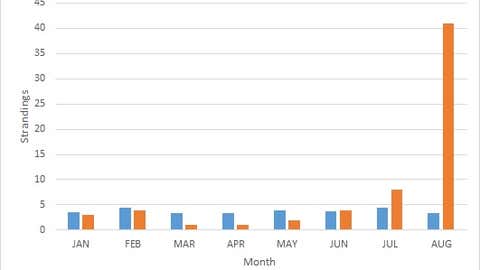
At a Glance
- Red tide is suspected in the deaths of 41 dolphins last month on Florida's southwest coast.
- NOAA Fisheries calls the deaths an "unusual mortality event."
- The dolphins could have been poisoned by the fish they eat.
Federal wildlife officials are investigating dozens of dolphin deaths off Florida's southwest coast which has been experiencing a severe red tide.
The red tide was confirmed last November, and dolphin deaths had remained in the normal range. Then in July the number hit eight, double the historic average. In August, the number soared to 41 deaths in which red tide is suspected, the Miami Herald reports.
The National Oceanic and Atmospheric Administration Fisheries agency has declared the deaths an "unusual mortality event." The declaration allows the agency to gather resources to study the ongoing deaths.
(MORE: Algae Bloom Serves as Food for Deadly Red Tide)
Florida's Gov. Rick Scott declared a state of emergency in mid-August because of the red tide, which is affecting seven counties: Collier, Lee, Charlotte, Sarasota, Manatee, Hillsborough and Pinellas.

Red tide is a naturally occurring algae bloom caused by Karenia brevis that forms in marine water. The algae make the water toxic for marine wildlife. This current bloom has killed goliath grouper, sea turtles and manatees, and tons of smaller fish. A 26-foot long whale shark washed up on the beach on Sanibel Island in Lee County.
Veterinarian Teri Rowles, coordinator for NOAA’s Marine Mammal Health and Stranding Program, told the Herald that dolphin deaths tend to lag behind turtles, manatees and other marine life because they are poisoned by the food they eat rather than the water.
“In red tide events, we know the animals often die acutely with high levels of brevetoxins in their bodies and in there stomachs,” she said. “But....even when the bloom is gone we may see an increase in mortality.”
Ten carcasses have been examined and all had high levels of red tide toxin, suggesting their deaths were linked to the algae bloom, Rowles said.
NOAA Fisheries says there was a similar event in 2005 and 2006 that killed about 190 dolphins along the Southwest Florida coast.



